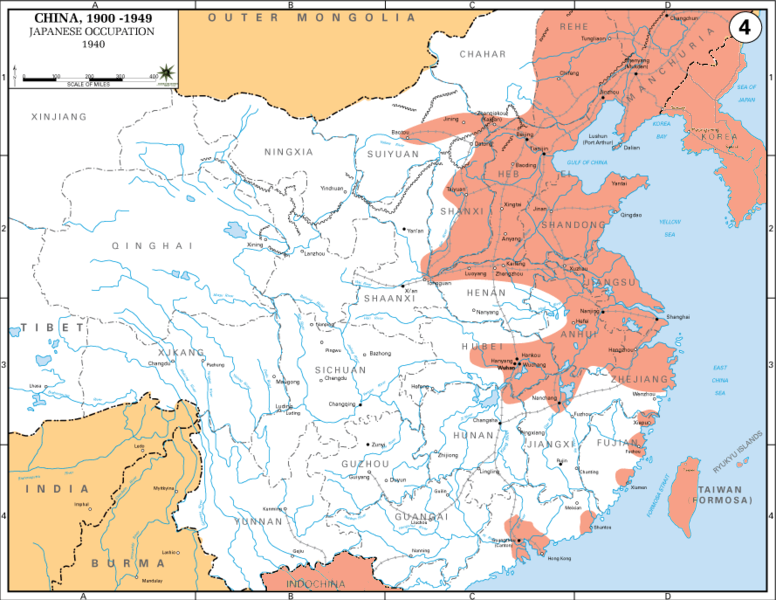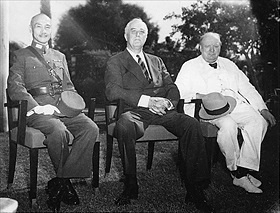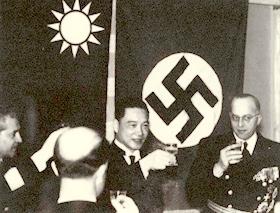CHINESE “QUISLING” OUSTS CHIANG KAI-SHEK REGIME
Nanjing (Nanking), China • March 30, 1940
By 1940 Japan had close to a decade’s worth of experience in administering conquered Chinese territory, having installed a puppet government in 1932 in Manchuria, which the Japanese called Manchukuo. On this date, March 30, 1940, in Nanjing (Nanking), China, the Japanese installed Wang Jingwei (Ching-wei) as head of state of the Japanese collaborationist government of the Republic of China. Wang had once headed a faction within the Chinese Nationalist Party, which the leaders in Tokyo hoped would prevail and accept peace terms that were advantageous to Japan (for instance, recognizing Manchukuo and accepting proposed demilitarized zones in dispute in Northern China) and bring the Sino-Japanese conflict to a negotiated end. When Wang lost his political struggle with Nationalist leader Chiang Kai-shek, Japan’s prime minister Fumimaro Konoe publicly declared his government’s intention to treat Chiang’s regime as illegitimate and annihilate it.
Nanjing had formerly been the capital of Chiang Kai-shek’s Nationalist government, which had moved the nation’s capital from Beijing (Peking). But following the Battle of Shanghai (August 13 to November 28, 1937), during which the Nationalist (Kuomintang) army unsuccessfully tried pushing Japanese soldiers out of China’s second largest city, Japan’s military leaders fixed their sights on revenge for the costly 4‑month-long battle in which roughly 320,000 combatants on both sides died. Plunder, destruction, sadism, rape, and murder were the names of the undisciplined Japanese foot soldiers who advanced on Nanjing. For 6 weeks following the city’s capitulation on December 13, 1937, thousands of civilians and disarmed soldiers were murdered and 20,000–80,000 men, women, and children were raped in what became known as the “Rape of Nanking.”
Wang headed a pro-Japanese regime that was strongly anti-Communist. In November 1941 he joined with the leaders of Japan, Italy, and Nazi Germany in the Anti-Comintern Pact, a 13‑nation alliance against the Soviet Union. Wang’s regime also stood in direct opposition to the American-supported government of Chiang Kai-shek, whose agents tried to assassinate Wang 2‑years earlier. (Chiang moved his government from Nanjing to Wuhan and later to Chongqing, or Chungking.) Wang’s government only held authority over Chinese territories under Japanese military occupation. It was deeply unpopular with the Chinese populace, and it was constantly undermined by resistance and sabotage from within and from Nationalist and Communist Chinese from without.
The 61-year-old Wang died in Japan, less than a year before that country’s surrender to the Allies in September 1945, thus avoiding a trial for treason and war crimes. Many of Wang’s followers who lived to see the end of the war were executed by his Nationalist and Communist opponents.
China and Wang Jingwei, Head of the Japanese Puppet Regime at Nanjing (Nanking)
 |
Above: Rose-colored shading marks the extent of Japanese-held China in 1940.
 |  |
Left: Wang Jingwei’s adversaries: Nationalist Chinese leader Generalissimo Chiang Kai-shek, U.S. President Franklin D. Roosevelt, and British Prime Minister Winston Churchill at the Cairo (Egypt) Conference, November 25, 1943. Chiang Kai-shek’s Nationalist government as well as his Communist Party rivals denounced Wang for being a Japanese collaborator (Nationalist viewpoint) and being anti-communist (Communist viewpoint).
![]()
Right: Wang Jingwei (1883–1944) toasts the German ambassador to Nanjing, Heinrich Georg Stahmer, 1941 or 1942. Wang’s regime flew the same flag as Chiang Kai-shek’s Nationalist Chinese. In 1943 Stahmer moved to Tokyo to head the German embassy there. When Germany capitulated to the Allies in May 1945, the Japanese interned Stahmer. Several months later after Japan had capitulated in September 1945, Stahmer was interned by the Americans, who released him in Germany in 1948. At the end of the Sino-Chinese war, Chiang Kai-shek moved his Nationalist capital back to Nanjing, destroyed Wang’s grave, and burned Wang’s body.
American John Magee: His Lone Camera Recorded the Tragedy of Nanjing Massacre
![]()

 History buffs, there is good news! The Daily Chronicles of World War II is now available as an ebook for $4.99 on Amazon.com. Containing a year’s worth of dated entries from this website, the ebook brings the story of this tumultuous era to life in a compelling, authoritative, and succinct manner. Featuring inventive navigation aids, the ebook enables readers to instantly move forward or backward by month and date to different dated entries. Simple and elegant! Click
History buffs, there is good news! The Daily Chronicles of World War II is now available as an ebook for $4.99 on Amazon.com. Containing a year’s worth of dated entries from this website, the ebook brings the story of this tumultuous era to life in a compelling, authoritative, and succinct manner. Featuring inventive navigation aids, the ebook enables readers to instantly move forward or backward by month and date to different dated entries. Simple and elegant! Click 











